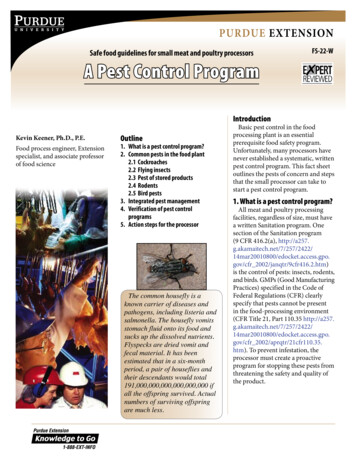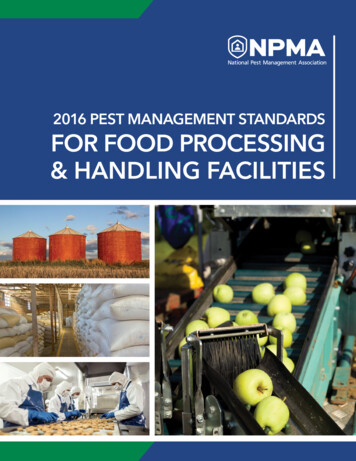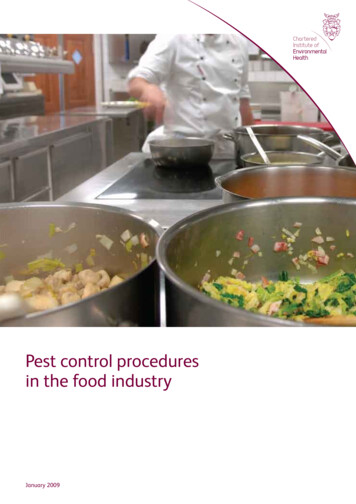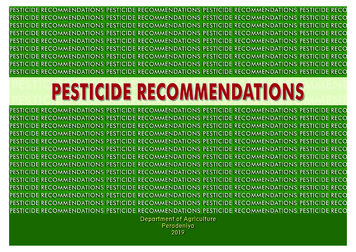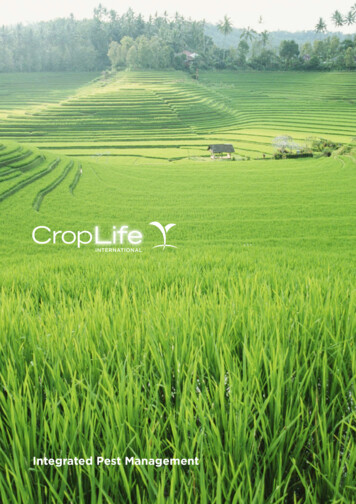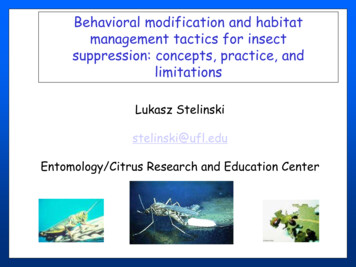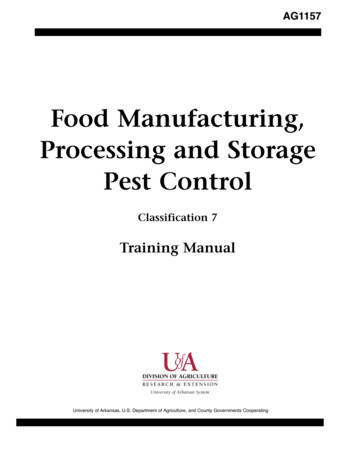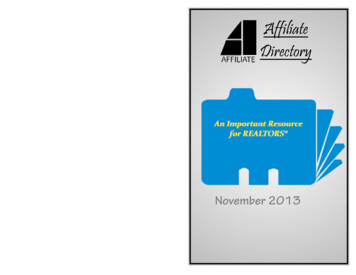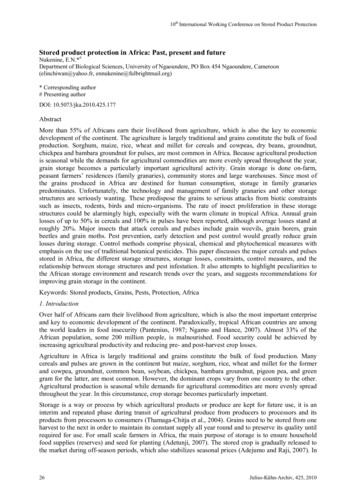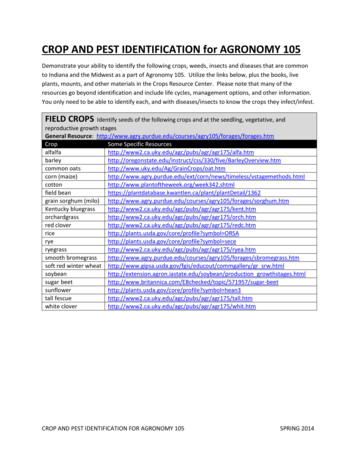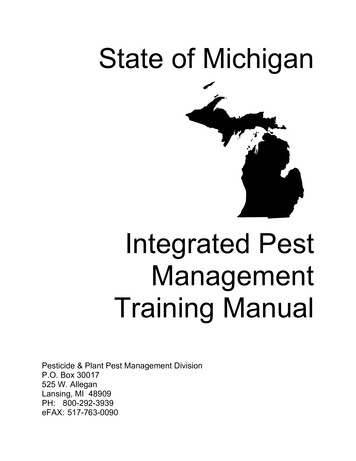
Transcription
State of MichiganIntegrated PestManagementTraining ManualPesticide & Plant Pest Management DivisionP.O. Box 30017525 W. AlleganLansing, MI 48909PH: 800-292-3939eFAX: 517-763-0090
The Michigan Department of Agriculture and Rural Development (MDARD), Pesticide and Plant PestManagement Division, IPM Steering Committee prepared this document.Special thanks to:Carolyn Randall, Michigan State University ExtensionMDARD Marketing and Communications StaffIPM Steering Committee MembersIPM Advisory TeamMDARD StaffPrefaceIn Michigan, Integrated Pest Management (IPM) is a requirement of law for persons who apply pesticides(other than sanitizers, germicides, disinfectants, or antimicrobial agents) in schools, day care centers, publicbuildings, and health care facilities. IPM is regulated under Michigan’s Natural Resources and EnvironmentalProtection Act, Act 451 of 1994, Part 83, Pesticide Control and under Michigan’s Regulation 637, PesticideUse.Regulation 637 requires pesticide applicators who are applying pesticides (other than sanitizers, germicides,disinfectants, or antimicrobial agents) in schools, day care centers, public buildings, and health care facilities toreceive verifiable training in IPM.Because IPM training must be verifiable, you will need to provide the Michigan Department ofAgriculture and Rural Development (MDARD), Pesticide and Plant Pest Management (PPPM) Divisionwith confirmation of your completion of this training manual. This is done by completing the trainingverification form found on page 16 of this manual and returning it to the MDARD office in Lansing. You will findthe address for the Lasing office on the form. Upon receipt of a properly completed form, the individual’s namewill be recorded into a database of IPM trained applicators and the individual will be issued anacknowledgement of receipt of the form.It is imperative that your training efforts be documented and recorded by the MDARD. The MDARD trainingrecords may be used to verify compliance with Michigan law for applicators utilizing this self-study tool andfailure to comply with those regulatory requirements could result in enforcement actions.If you have any questions, please contact the MDARD at 800-292-3939.State of Michigan IPM Training ManualVer. 12/09
TABLE OF CONTENTSINTRODUCTION/PURPOSE OF THE MANUAL1KEY TERMS2SECTION I – REGULATORY REQUIREMENTSState of Michigan Requirements4SECTION II – ESTABLISHING YOUR IPM PROGRAMSetting the Tone8Writing Your IPM Program9SECTION III – SAMPLES & FORMS15Verification of Training Form16Common Pests Description - Example17IPM Pest Sighting Log21Pest Reporting Monitoring Station Report22Applicator Information Log23Pesticide Recordkeeping Form24Advisory to Parents/Guardians25Request for Notice of Pesticide Application26Notice of Pesticide Treatment27SECTION IV -- REVIEWIPM Resources28Review Questions29State of Michigan IPM Training ManualVer. 12/09
INTRODUCTIONPesticides are used to protect food and non-food crops, pets, homes and ourselves from pests. Publicconcern about health and environmental risks associated with the application of pesticides has been an issuefor many years. In order to address this concern, pest managers and regulatory agencies are promoting theuse of effective alternative pest control methods. Managers with pest control decision-making responsibilitiesshould become aware of the pest control options available to reduce exposure to potentially harmful pesticides.Integrated Pest Management (IPM) is defined as a pest management system that utilizes all suitabletechniques in a total management system with the intent of preventing pests from reaching unacceptable levelsor to reduce an existing population to an acceptable level. An emphasis is placed on manipulation of the pest’senvironment to the point that it will not support a pest population. Biological controls may also be used.IPM can also be defined as an effective and environmentally sound approach to pest management that relieson a combination of common sense practices. Its purpose is to manage pests with the least possible hazard topeople, property and the environment. IPM is a comprehensive approach to pest management.The State of Michigan has enacted laws to require the use of IPM in certain situations. Act 451, Part 83, Pesticide Control requires that an IPM program be in place for the building before anypesticide applications (other than sanitizers, germicides, disinfectants, or antimicrobial agents) aremade in schools, day care centers, public buildings, or health care facilities.Regulation 637, Pesticide Use, Rule 14 requires the MDARD to provide information regarding IPM.The law also requires a pesticide applicator who makes a pesticide application in an IPM regulatedfacility to have participated in a verifiable IPM training program approved by the MDARD prior tomaking the pesticide application.PURPOSE OF THIS MANUALThe MDARD has prepared this manual to: Provide information as required by Regulation 637, Rule 14.Assist persons applying pesticides in regulated institutions.Comply with the IPM training requirement.Guide the development of an IPM program.It is not the intention of this booklet to discuss prevention and control of specific structural pests, but to offerexamples of IPM strategies.State of Michigan IPM Training ManualVer. 2/20131
KEY TERMSApplicator: A person who applies pesticides by any method for any purpose at any place.Biological control: A reduction of pest populations by natural enemies such as predatory insects orpathogens of the pest.Building manager: A person who is designated as being responsible for the building’s pest managementprogram and to whom any reporting and notification shall be made.Certified applicator: A person authorized under Act 451, Part 83, Pesticide Control to use and supervise theuse of a restricted-use pesticide.Commercial applicator: A person who is required to be a registered or certified applicator under Act 451,Part 83, Pesticide Control, or who holds themself out to the public as being in the business of applyingpesticides. A commercial applicator does not include a person using a pesticide for a private agriculturalpurpose.Commercial building: Any portion of a building that is not a private residence where a business is locatedand that is frequented by the public.Day care center: A facility, other than a private residence, which receives one or more preschool or schoolage children for care for periods of less than 24 hours a day, at which the parents or guardians are notimmediately available to the child, and which is licensed as a child care organization by the MichiganDepartment of Human Services in accordance with Public Act 116 of 1973, as amended, MCL section 722.111to 722.128.General use pesticide: A pesticide that is not classified as a restricted use pesticide and can be purchasedwithout restriction.Health care facility: A facility which is not a private home and at which people may stay one or more nightsand receive medical care, such as a hospital or nursing home.Integrated pest management: A pest management system that uses all suitable techniques in a totalmanagement system to prevent pests from reaching unacceptable levels or to reduce existing pest populationsto acceptable levels.Incidental use: The application of a general use pesticide as an accompanying minor occurrence to a primarywork function. Example: A postman who uses a dog repellent.Multiple-use area: Developed outdoor public recreation areas, such as campgrounds, rest areas, parks,playgrounds, picnic areas, and athletic fields. The term does not include undeveloped forest areas.Notification registry: A list of persons who require notification before a turf or ornamental pesticide is appliedon a property that is adjacent or near their property as described in Regulation 637, Pesticide Use, Rule 5.Pest: An insect, rodent, nematode, fungus, weed, and other forms of terrestrial or aquatic plant or animal lifeor virus, bacteria, or other microorganism, or any other organism that the director declares to be a pest.Pesticide: A substance or mixture of substances intended for preventing, destroying, repelling, or mitigatingpests, or intended for use as a plant regulator, defoliant, or desiccant.State of Michigan IPM Training ManualVer. 2/20132
Public building: A building that is owned or operated by a federal, state, or local government, including publicuniversities.Ready-to-use pesticide: A pesticide that is applied directly from its original container consistent with labeldirections, such as an aerosol insecticide or a rodenticide bait pack that does not require mixing or loadingprior to the application.Re-entry interval: The period of time between the application of a pesticide and the time when people areallowed to return to the treated area without personal protective equipment. Note that liquid, spray or aerosolinsecticide applications shall not be made in any room of a school building unless the room will not beoccupied by students for not less than four hours after the application, unless the product label requires alonger re-entry period. The building manager shall be notified of the re-entry restrictions by the applicator.Registered applicator: A person who is not a commercial certified applicator and who is one or more of thefollowing: Authorized to apply general use pesticides for a commercial purpose as provided in Act 451, Part 83,Pesticide Control and the rules promulgated under the Act.Authorized under Act 451, Part 83, Pesticide Control to apply general use pesticides as a scheduledand required work assignment in the course of his or her employment on the property of another personfor any purpose.Restricted use pesticide: A pesticide that is classified for restricted use by the federal EnvironmentalProtection Agency or by the MDARD director.Sensitive area: This includes any of the following: Occupied school buildings, together with any land that is part of the same property and is within 100feet of such buildings, and includes any playgrounds, athletic fields, or other such facilities which are inthe vicinity of school buildings and which are in use at the time of the pesticide application.Commercial preschool and day care facilities that are located in buildings which are identified by signsor other means and which are recognizable to the public.Posted bus stops which are identified by signs and which are recognizable to the public.School: Public and private schools, grades kindergarten through the twelfth grade.Use of a pesticide: The loading, mixing, applying, storing, transporting, or disposing of a pesticide.ACRONYMS USED IN THIS MANUALEPAIPMMDARDPPEPPPMState of Michigan IPM Training ManualVer. 2/2013Environmental Protection AgencyIntegrated Pest ManagementMichigan Department of Agriculture and Rural DevelopmentPersonal Protective EquipmentPesticide & Plant Pest Management3
SECTION I – REGULATORY REQUIREMENTSState of Michigan Regulatory RequirementsMichigan law requires pesticide applicators who apply pesticides as part of their work activities to be a certifiedapplicator or a registered applicator, with some exceptions being given for agricultural producers (farmers) andfor persons who are using general-use ready-to-use pesticides. A custodian using a hand-pump sprayer inwhich pesticides were mixed from concentrate would need to be certified or registered. A person who appliesa granular weed-and-feed product from a spreader as part of their work activities would need to be certified orregistered.State and federal law require pesticides to be used in accordance with the product labeling. Strict adherenceto label requirements helps to ensure the protection of the applicator and the environment.State law requires that before a pesticide application is made in a school, day care center, public building, orhealth care facility: The pesticide applicator must have participated in a verifiable training program (studying this manualand submitting the verification of training form fulfills that requirement), andThere must be a verifiable IPM program in place for the facility.In addition, pesticide applications made in schools, day care centers, health care facilities, and public buildingsmust be made in accordance with specific requirements for posting, notification, reentry, and IPM. Theserequirements are found in: The Natural Resources and Environmental Protection Act, Act 451 of 1994, Part 83, Pesticide ControlRegulation 636, Pesticide ApplicatorsRegulation 637, Pesticide UseSome of the highlights of these regulatory requirements are described below. If you have further questionspertaining to the regulatory requirements of pesticide use, please contact your local the Michigan Departmentof Agriculture and Rural Development, Pesticide and Plant Pest Management Division at 800-292-3939.Act 451, Part 83, Pesticide Control, Section 8316 IPM Program Requirement for Schools and Day Care CentersParent/Guardian Notification for Schools & Day Care CentersReentry Requirements for Schools & Day Care Centers1. A verifiable IPM Program must be in place prior to use of a pesticide in a school or day care center.The term “integrated pest management program” is defined in Section 8304(6). The definition islengthy and it provides a number of details regarding the specific data elements that an IPM programmust include. The words “day care center” and “school” are defined in Section 8303(1) and 8306(7)respectively.2. Schools and day care centers must annually notify the parents/guardians of children who attend theschool or day care center that they will receive advance notification of the application of a pesticide,other than a bait or gel formulation, at the school or day care center. Schools must provide this writtennotification within 30 days of the beginning of the school year. Day care centers must provide theinformation during the month of September. (Please note that a sample of an annual notification formis included in this manual on page 26.)State of Michigan IPM Training ManualVer. 2/20134
3. The annual notification shall satisfy the following requirements:a. The notice shall be made in writing.b. The notice shall specify 2 methods by which the advance notification of the application of apesticide will be given at least 48 hours before the application. The first method shall be byposting the entrances to the school or day care center. Subject to subdivision (c), the secondmethod shall be at least one of the following:i. Posting in a public, common area of the school or day care center, other than anentrance. A bulletin board near the administrative offices is an example of anacceptable area.ii. E-mail.iii. A telephone call by which direct contact is made with a parent/guardian of a student ofthe school or a child under the care of the day care center, or a message is recorded onan answering machine.iv. Providing the students of the school or children under the care of the day care centerwith a written notice to be delivered to their parents/guardians.c. State that, in addition to notice under subdivision (b), parents/guardians are entitled to receivethe notice by first-class United States mail postmarked at least 3 days before the application, ifthey so request, and the manner in which such a request shall be made.d. For a school, inform the parents/guardians that they may review the school’s IPM Program, ifany, and records on any pesticide applications.e. For a school, provide the name, telephone number, and, if applicable, e-mail address of theperson at the school building responsible for pesticide application procedures.4. Before the application of a pesticide, other than a bait or gel formulation, the school or day care centermust provide parents/guardians with the advance notification. (Please note that an example of a formthat can be used for the advance notification is included in this manual on page 27.) An advancenotification shall contain all of the following information:a.b.c.d.e.f.A statement that a pesticide is expected to be applied.The target pest(s).The approximate location of the application.The date of the application.The name, telephone number, and, if available, email address of a contact person at the schoolor day care center who is responsible for maintaining records with specific information on pestinfestation and actual pesticide application as required by rules.A toll-free telephone number for a national pesticide information center recognized by theMDARD and a telephone number for pesticide information from the MDARD.5. Before applying a pesticide, other than a bait or gel formulation, a school or day care center shallprovide advance notice to parents and guardians consistent with subsections (3)(b) to (e) and (4).However, in an emergency (such as a treatment to kill stinging insects) a school or day care center mayapply a pesticide without providing advance notice to parents/guardians. Promptly after the emergencypesticide application, the school or day care center shall give parents/guardians notice of theemergency pesticide application that otherwise meets the requirements of subsection (3)(b) and (c).The notice shall contain a statement that a pesticide was applied and shall meet the requirements ofsubsection (4)(b) to (f).6. Use of any liquid spray or aerosol insecticide application shall not be made in a school or day careunless the room will be unoccupied by students or children for not less than 4 hours after theapplication or unless the product label requires a longer reentry period.7. Subsections (1) to (6) do not apply to sanitizers, germicides, disinfectants, or antimicrobial agents.State of Michigan IPM Training ManualVer. 2/20135
Please note that Regulation 637, Pesticide Use, Rule 15 also includes requirements for the annual notificationto parents/guardians. The regulation requires that the annual notification includes a statement that indicatesthe location(s) of the primary point(s) of access at which the advance notification of a pesticide treatment willoccur.In addition, please note that Regulation 637, Pesticide Use, Rule 15 also allows schools to utilize a messagesystem for advance notification of a pesticide treatment during the months when school is not in regularsession. The rule requires any school using such a system to provide information to parents/guardiansregarding how that information can be obtained.Regulation 637, Pesticide Use, Rule 11 Posting Requirements Following the Use of a PesticideIndoor Insecticide Treatments:If you make insecticide applications, other than with a general-use ready-to-use pesticide, to any of thefollowing sites, then you must provide posting. The sites include:1.2.3.4.A commercial or public building.A health care facility.A day care center.A school.If you make a broadcast, foliar or space application of an insecticide inside a commercial building, publicbuilding, or health care facility, then you must provide a sign to be displayed at the primary point(s) of entry intothe building by the building manager. The sign must:1.2.3.4.5.Be posted for not less than 48 hours.Be a minimum of 2 ½ inches by 2 ½ inches.Be printed in black letters on a muted background.Include a symbol of a house encompassed by a cloud.Include a space for the date of application to be recorded.Lawn and Ornamental Plant Treatments:If you make pesticide applications to turf (lawn) or ornamental sites at a location such as a school, day carecenter, commercial building, public building, or health care facility, then the site must be posted immediatelyfollowing the pesticide treatment with a lawn marker sign at the primary point(s) of entry to the treated area.Lawn marker signs shall be in compliance with all of the following specifications:1. Be a minimum of 4 inches high by 5 inches wide.2. Be constructed of rigid, weather-resistant material.3. Be attached to a supporting device with the bottom of the marker extending not less than 12 inchesabove the turf.4. Be identically printed on both sides in green letters on a white background using the indicated pointtype size specified.5. Include all of the following information:a. The statement “CAUTION” in 11/16-inch high (72-point) type.b. The statement “Pesticide Application” in 9/32-inch (30-point) type.c. The statement “Keep Off Until Dry” in 9/32-inch (30-point) type.State of Michigan IPM Training ManualVer. 2/20136
d. Have not less than a 2-inch diameter circular illustration that depicts an adult and child walking adog on a leash. The illustration shall depict, using a diagonal line across the circle, that thisaction is prohibited.e. The statement “Customer: Please Remove After 24 Hours” in3/32-inch (11-point) type.6. Additional information not specified in this rule may only be placed on thelawn marker and supporting devise upon the written approval of theMDARD.Regulation 637, Pesticide Use, Rule 14 IPM Training Requirements for Public Buildings and Health Care FacilitiesIPM Program Requirements for Public Buildings and Health Care FacilitiesThis rule requires any person who applies a pesticide, (other than a sanitizer, germicide, disinfectant orantimicrobial agent), in a school, day care center, public building or health care facility, to have participated in averifiable IPM training program which is approved by the MDARD. This IPM Training Manual serves as anapproved IPM training program for the purposes of this rule.This rule requires that a verifiable IPM Program be in place prior to the application of a pesticide (other than asanitizer, germicide, disinfectant, or antimicrobial agent) that is applied in a public building or health carecenter. Note that schools and health care centers are included in the Act.Regulation 637, Pesticide Use, Rule 15 Pesticide Use In and Around Schools and Day Care CentersAll applications of insecticides, fungicides, and herbicides that are made in and around schools and day carecenters are subject to the provisions of this rule.1. A 100 foot buffer must be maintained between occupied classrooms and a turf or ornamental sitewhere liquid spray pesticide applications are made during normal school class hours or when personsare using the treatment area.2. A pesticide applicator must notify the building manager of any reentry periods required by the label(s) ofany pesticides used on school or day care property.3. The annual notification of pesticide applications to parents/guardians as required under the Act shallinclude a designation of the commonly used primary entrances at which the posting of pesticideapplication information (as required under the Act) shall occur.4. During the months when school is not in regular session, school administrators may utilize a messagenotification system that parents/guardians may access at least 1 day before any pesticide application.If this alternative is utilized, parents/guardians shall be advised as to how the information may beobtained.State of Michigan IPM Training ManualVer. 2/20137
SECTION II – ESTABLISHING YOUR IPM PROGRAMSetting the ToneAn efficient IPM program should be integrated with existing facility management programs such as janitorialpractices, lawn care and facility maintenance. An efficient IPM program should include the cooperation of thestaff using the facility. The following steps are an example of how an IPM program can be developed:1.Develop an official IPM policy statement. This useful first step in making the transition from aconventional pesticide program to an IPM program goes beyond simply stating a commitment tosupport and implement an IPM approach. It acts as a guide for the pest manager to use in developing aspecific IPM program.Designate pest management roles for occupants, pest-management personnel, and key decisionmakers, and assure good communication among them. Educate and train people for their respectiveroles.Set pest management objectives for the site(s). For every site, pest management objectives will differ.The type of pest management should be outlined.Inspect site(s) and identify and monitor pest populations for potential problems.Set action thresholds. These are the levels of pest populations or site environmental conditions thatrequire remedial action.Apply IPM strategies to control pests. These include redesigning and repairing structures, improvingsanitation, using traps and applying pesticides only when needed.2.3.4.5.6.CommunicationFor your IPM program to function effectively, it is necessary to have good two-way communication betweenthose who are conducting the IPM program and the users of the facility. Much of the communication will takeplace between the building manager and the pesticide applicator directly.Communication can take many forms, such as speaking with staff members about pest sightings, discussingways to reduce pest populations through improved housekeeping or by making repairs, and by soliciting staffcooperation. One way of obtaining staff cooperation is by explaining to the users of the facility how IPMenhances and compliments the “regular” pest control service where pesticides are applied.Communication educates the users of the facility and other interested parties about potential pest problems,their causes, and the IPM solution. Simply having informed individuals who will spot and report pest problemscan go a long way toward managing pests.The building manager and the IPM technician must work together and obtain cooperation from the building’soccupants to ensure the program’s success. They should communicate to the occupants what theirresponsibilities are and how they (the occupants) can help implement the IPM program.Commercial applicator responsibilities: Ensure that the building manager has a copy of the IPM program and initial service inspection record.Obtain acceptance from the building manager that he/she will post any required signs.Provide to the building manager the required recordkeeping information at the completion of eachservice.State of Michigan IPM Training ManualVer. 2/20138
Building manager responsibilities: Accept the responsibility to post all required signs.Assist the commercial pesticide applicator with the implementation of the IPM program and plan.Ensure that each facility has a complete IPM program in place at all times.Writing Your IPM ProgramRequired IPM Components:Michigan law has certain requirements regarding the content of a verifiable IPM program. In Act 451, Part 83,Pesticide Control, Section 8304(6) the law lists all of the IPM Program data elements that are required(marked *) to be included in an IPM Program. This portion of the IPM Manual will assist you in setting up anIPM Program. The required components are identified with an asterisk next to the subtitle in this section.However, to make your IPM Program easier to use, we strongly recommend that additional components arealso included in your plan.A.Policy StatementA policy statement should state the intent of the facility administration to implement an IPM program. Itshould provide guidance on what is expected. The following is an example of a policy statement:(Name of your facility) recognizes that structural and landscape pests can pose significant problems tostudents/staff, school facilities, and the environment. We also recognize that pesticides may posehazards to the health and safety of the same people and the environment. Therefore, it is the policy of(your facility) to incorporated IPM procedures for the control of pests to better control these pests whilereducing the potentially adverse effects of pesticides. These procedures will be in compliance withMichigan law, The Natural Resources and Environmental Protection Act, Act 451 of 1994, Part 83,Pesticide Control, and the rules promulgated thereunder.B.Definitions SectionTerms such as IPM, pest, pesticide, RTU, building manger, biological control, chemical control,habitation modification, structural modification, and behavior modification are words that some peoplemay not be familiar with. A definitions section will help clarify confusion about terminology. It isimportant that all parties using the IPM Program understand what the program is describing and thatthey agree on the basic principals and practices of the program.C.Responsibility SectionDesignating pest management roles of the parties involved is an important key to the success of theIPM program. When the respective roles of all the parties involved are identified and agreed upon, andwhen parties communicate well with each other and meet their responsibilities, then a successfuloutcome is much more likely. For example: The building manager is responsible for the buildings pest management program. Any reportingand notification shall be made to the building manager.The pest control operator and/or pesticide applicator shall monitor and evaluate the site anddecide what actions need to be taken to achieve the site’s pest management objectives.He/she will perform the necessary pest management actions and/or will recommend to thebuilding manager actions to be taken at the facility.State of Michigan IPM Training ManualVer. 2/20139
D.The custodial staff is responsible for sanitation and monitoring of the site for pest infestation.Much of the prevention and control of pests depends on whether or not proper maintenance andcleaning is performed. Custodial staff will report to the building manager regarding pest controlissues.The facility employees are responsible for sanitation and monitoring of their work areas. Storingsnacks in work areas can attract pests to the site. Facility employees will report pest sightingsand unsanitary conditions to the building manager for further action.Site Evaluation *Site evaluation is a vital step in establishing the condition of the facility as it relates to pestmanagement. The following four basic elements are required by law in a site evaluation: Site Descript
State of Michigan IPM Training Manual 2 Ver. 2/2013 KEY TERMS Applicator: A person who applies pesticides by any method for any purpose at any place. Biological control: A reduction of pest populations by natural enemies such as predatory insects or pathogens of the pest. Building manager: A person who is designate
